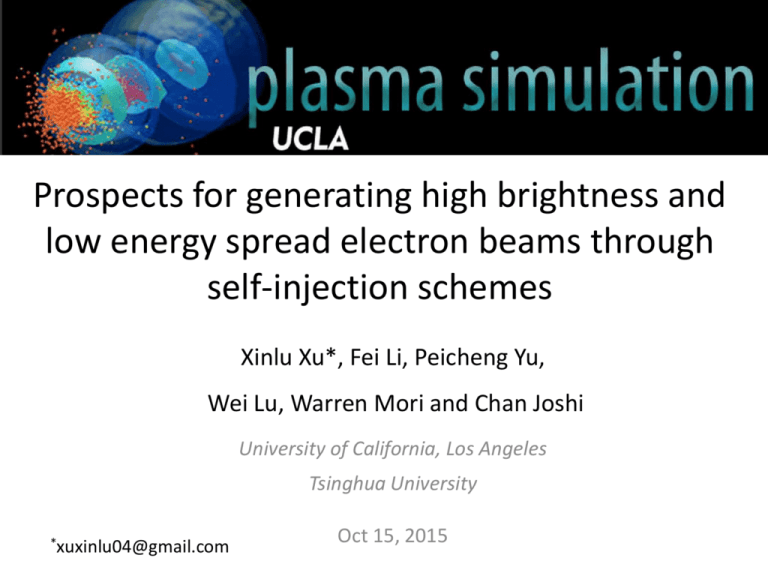Talk-Xinlu-XFEL
advertisement

Prospects for generating high brightness and low energy spread electron beams through self-injection schemes Xinlu Xu*, Fei Li, Peicheng Yu, Wei Lu, Warren Mori and Chan Joshi University of California, Los Angeles Tsinghua University *xuxinlu04@gmail.com Oct 15, 2015 Plasma-based acceleration • Plasma-based acceleration1: High gradient: ~ 100 GV/m High efficiency: ~ 30% High energy gain: ~ 10s GeV Beam quality ? Emittance Brightness current energy spread 1T. Hard X-FEL at LCLS2 ~0.4×1017 A/m2/rad2 (~3 kA, ~400 nm) < ρ ~ 0.001 Tajima and J. M. Dawson, Phys. Rev. Lett., 43, 267 (1979); P. Chen et al., Phys. Rev. Lett., 54, 693 (1985); I. Blumenfeld, et al., Nature 445, 741-744 (2007); W. P. Leemans, et al., Phys. Rev. Lett., 113, 245002 (2014); M. Litos, et al., Nature 515, 92-95 (2014); and many other papers. 2P. Emma et al., Nature Photonics 4, 641-647 (2010). Experimental results Question: How to generate an electron beam with both much higher brightness (>1017 A/m2/rad2) and much lower energy spread (<1%) in plasmabased accelerators? Injection schemes • What is injection? The electron is in the acceleration phase. Injection schemes • External Injection1: the electrons from other sources, e.g., RF-based accelerators • Self Injection: the electrons from the plasma Ionization Injection2 Downramp Injection3 Others 1C. E. Clayton et al., Phys. Rev. Lett. 70,37 (1993); M. Everett et al., Nature 368, 527 (1994). Oz et al., Phys. Rev. Lett. 98, 084801 (2007); A. Pak et al., Phys. Rev. Lett. 104, 025003 (2010). 3C. G. R. Geddes et al., Phys. Rev. Lett. 100, 215004 (2008); A. J. Gonsalves, et al., Nature Phys. 7, 862-866 (2011); A. Buck, et al., Phys. Rev. Lett. 110, 18506 (2013). 2E. Ionization injection – Different Scenarios Ionization injection- The key physics Transverse Phase Mixing Longitudinal Phase Mixing Transverse phase mixing happens in each slice. The slice energy spread is determined by the injection distance, ~ several MeV. X. Xu et al., Phys. Rev. Letts. 112, 035003 (2014). Ionization injection by transverse colliding pulses injection Peak brightness: 1.7×1019 A/m2/rad2 Slice energy spread: 0.012 MeV F. Li et al., Phys. Rev. Letts. 111, 015003 (2013). Downramp injection • “Accordion effect”: S. Bulanov, et al., and H. Suk et al., studied the injection process using 1D analysis. We are studying downramp injection: In the 3D blowout regime With the aim of generating unprecedented beam quality ~ 1020 A/m2/rad2 + ~1 MeV ! T. Katsouleas, Phys. Rev. A 33, 2056 (1986); S. Bulanov, et al., Phys. Rev. E 58, R5257 (1998); H. Suk, et al., Phys. Rev. Lett. 86, 1011 (2001); Downramp Injection – The phase velocity • We focus on: 3D blowout regime Gradual density ramp: Injection condition: • The phase velocity W. Lu et al., PRL 96, 165002 (2006) 1.5 np0 np0 Downramp injection – transverse motion • The transverse force for the particle at r=rb Defocusing Focusing Downramp injection – General features of the injected electrons Downramp injection – Beam Quality Emittance εn: determined by σri Slice energy spread: determined by σzi Current: How to generate a beam with high brightness? • Scaling: One stage Laser driver: np ~ 1019 cm-3 and higher How to generate a beam with high brightness? • Staging: ~ 0.8×1021 A/m2/rad2, < 2 MeV 50 um: 3.3×1018cm-3 2.6×1018cm-3 16 um: 2.3×1020cm-3 1.4×1020cm-3 How to generate a beam with low projected energy spread? initial energy chirp the chirp of acceleration gradient How to generate a beam with low projected energy spread? • Laser driver case: at zplasma = 0.17 mm How to further reduce the relative projected energy spread? The ramp length L is increased from 17 c/ωp to 150 c/ωp. The beam duration is mainly determined by the density difference (np,h - np,l). Increase the ramp length to increase the initial energy chirp κ ! How to further reduce the relative projected energy spread? • Generate an ultrashort beam. The plasma density is decreased from 1.05 np to np in 2 c/ωp. 1018 cm-3: ~20 nm Other issues - Matching X. Xu, et al., arXiv:1411.4386 (2014) • Parameters: Profile of the matching section 1017 cm-3 • OSIRIS results: Conclusions • We studied the density downramp injection in the 3D blowout regime driven by charged particle or laser pulses. • The phase space dynamics of the injection beams are studied using 3D simulations and theoretical analysis. • The current, emittance, beam length and initial energy chirp can be controlled by adjusting the driver intensity and the ramp parameters. • Finally, electron beams with both high brightness and low energy spread can be generated. Thanks for your attention! Downramp injection – The particle velocity • In a uniform plasma: with the quasi-static approximation1: The distribution of Ψ1: P. Mora and T. M. Antonsen Jr, Physics of Plasma 4, 217 (1997). Downramp injection – The particle velocity • In a uniform plasma: Downramp injection – General features of the injected electrons


![[1]. In a second set of experiments we made use of an](http://s3.studylib.net/store/data/006848904_1-d28947f67e826ba748445eb0aaff5818-300x300.png)

